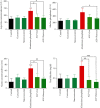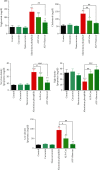Nanocurcumin Improves Lipid Status, Oxidative Stress, and Function of the Liver in Aluminium Phosphide-Induced Toxicity: Cellular and Molecular Mechanisms
- PMID: 36132078
- PMCID: PMC9484886
- DOI: 10.1155/2022/7659765
Nanocurcumin Improves Lipid Status, Oxidative Stress, and Function of the Liver in Aluminium Phosphide-Induced Toxicity: Cellular and Molecular Mechanisms
Abstract
Background: The present study aimed to evaluate the effect of nanocurcumin and curcumin on liver transaminases, lipid profile, oxidant and antioxidant system, and pathophysiological changes in aluminium phosphide (ALP) induced hepatoxicity. Material and Methods. In this experimental study, thirty-six male Wistar rats were randomly divided into six groups curcumin (Cur), nanocurcumin (Nanocur), ALP, ALP+Cur, and ALP+Nanocur. All treatments were performed by oral gavage for seven days. After treatment, animals were sacrificed, and liver and blood samples were taken. Serum levels of aspartate aminotransferase (AST), alanine transaminase (ALT), alkaline phosphatase (AP), total bilirubin, cholesterol, triglyceride, high-density lipoprotein (HDL), low-density lipoprotein (LDL), and very-low-density lipoprotein (VLDL) were measured by photometric methods. Total antioxidant capacity (TAC) and malondialdehyde (MDA) as parameters of oxidative stress and mRNA expression of the nonenzyme protein including Sirtuin 1 (STR1), Forkhead box protein O1 (FOXO1) and protein O3 (FOXO3), catalase (CAT), and glutathione peroxidase (GPX) as the enzyme protein in homogenized tissues have been investigated. A histologist analyzed liver tissue sections after staining with hematoxylin-eosin.
Results: In the aluminium phosphide group, there was a significant increase in MDA, ALT, AST, and AP and total bilirubin, cholesterol, triglyceride, LDL, and VLDL; AST, ALT, total bilirubin, LDL, VLDL, cholesterol, and MDA were significantly decreased; and HDL and TAC were significantly increased compared to ALP (P < 0.05). In the ALP+Nanocur group, ALT, AST, ALP, total bilirubin, cholesterol, LDL, VLDL, triglyceride, and MDA were significantly decreased and HDL and TAC were increased significantly (P < 0.05). The effect of nanocurcumin on controlling serum levels of LDL, VLDL, triglyceride, and MDA in ALP-poisoned rats was significantly more than curcumin (P < 0.05). The ALP group had significant changes in genes SIRT1, FOXO1a, FOXO3a, CAT, and GPX compared to healthy controls (P < 0.05). Nanocurcumin mice expressed more SIRT1, FOXO1a, CAT, and GPX genes than controls, and curcumin-treated mice expressed more SIRT1 and FOXO1a genes (P < 0.05). Histopathological findings also indicated a more significant protective effect of nanocurcumin relative to curcumin against ALP-induced hepatotoxicity.
Conclusion: Nanocurcumin significantly protects the liver against aluminum phosphide toxicity. It is suggested that nanocurcumin-based drugs be developed to reduce the toxic effects of ALP in poisoned patients.
Copyright © 2022 Ali Salimi et al.
Conflict of interest statement
The authors declare that they have no conflict of interest.
Figures





Similar articles
-
An Oxidative Stress Study on Curcumin and NanoCurcumin against Aluminum Phosphide-induced Kidney Injury in Rats: The Role of SIRT1/FOXO3 Signaling Pathway in Nephrotoxicity.Pharm Nanotechnol. 2024;12(5):449-458. doi: 10.2174/2211738511666230821124704. Pharm Nanotechnol. 2024. PMID: 37605419
-
Protective Effect of Curcumin and Nanocurcumin on Sperm Parameters and Oxidant-antioxidants System of Rat Testis in Aluminium Phosphide Subacute Poisoning.Pharm Nanotechnol. 2023;11(4):355-363. doi: 10.2174/2211738511666230316101414. Pharm Nanotechnol. 2023. PMID: 36927427
-
Evaluation of Protective Effects of Curcumin and Nanocurcumin on Aluminium Phosphide‑Induced Subacute Lung Injury in Rats: Modulation of Oxidative Stress through SIRT1/FOXO3 Signalling Pathway.Drug Res (Stuttg). 2022 Feb;72(2):100-108. doi: 10.1055/a-1647-2418. Epub 2021 Oct 6. Drug Res (Stuttg). 2022. PMID: 34614532
-
Discovering the most impactful treatments for aluminum phosphide cardiotoxicity gleaned from systematic review of animal studies.Hum Exp Toxicol. 2024 Jan-Dec;43:9603271241290922. doi: 10.1177/09603271241290922. Hum Exp Toxicol. 2024. PMID: 39378909
-
The Impact of Curcumin, Resveratrol, and Cinnamon on Modulating Oxidative Stress and Antioxidant Activity in Type 2 Diabetes: Moving beyond an Anti-Hyperglycaemic Evaluation.Antioxidants (Basel). 2024 Apr 24;13(5):510. doi: 10.3390/antiox13050510. Antioxidants (Basel). 2024. PMID: 38790615 Free PMC article. Review.
Cited by
-
Ameliorative anti-coagulant, anti-oxidative and anti-ferroptotic activities of nanocurcumin and donepezil on coagulation, oxidation and ferroptosis in Alzheimer's disease.Toxicol Res (Camb). 2024 Apr 10;13(2):tfae054. doi: 10.1093/toxres/tfae054. eCollection 2024 Apr. Toxicol Res (Camb). 2024. PMID: 38617712 Free PMC article.
-
Unveiling the emerging role of curcumin to alleviate ochratoxin A-induced muscle toxicity in grass carp (Ctenopharyngodon idella): in vitro and in vivo studies.J Anim Sci Biotechnol. 2024 May 12;15(1):72. doi: 10.1186/s40104-024-01023-6. J Anim Sci Biotechnol. 2024. PMID: 38734645 Free PMC article.
-
Curcumin: A Natural Warrior Against Inflammatory Liver Diseases.Nutrients. 2025 Apr 18;17(8):1373. doi: 10.3390/nu17081373. Nutrients. 2025. PMID: 40284236 Free PMC article. Review.
-
Effect of nanocurcumin administration on superoxide dismutase and progesterone level exposure to noise stress during pregnancy in mice.Open Vet J. 2025 Mar;15(3):1239-1243. doi: 10.5455/OVJ.2025.v15.i3.15. Epub 2025 Mar 31. Open Vet J. 2025. PMID: 40276195 Free PMC article.
-
Nano-Curcumin Mitigates Doxorubicin-Induced Reproductive Toxicity via Antioxidant, Anti-Apoptosis, and SIRT1-Modulating Effects in Rat Model.Toxics. 2025 Jul 8;13(7):574. doi: 10.3390/toxics13070574. Toxics. 2025. PMID: 40711019 Free PMC article.
References
-
- Rahbar T. M., Teymourpour P., Jahanbakhsh R. Survey the histopathological findings in autopsy of poisoned patients with rice tablet (aluminium phosphide) Journal Of Guilan University Of Medical Sciences . 2011;19:56–63.
MeSH terms
Substances
LinkOut - more resources
Full Text Sources
Medical
Research Materials
Miscellaneous

